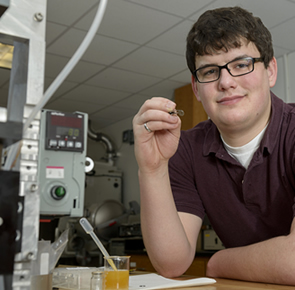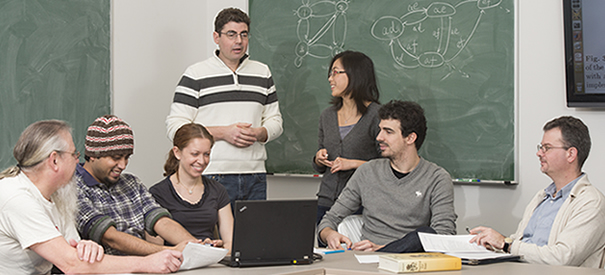When the Smithsonian American Art Museum contacted Kristin de Ghetaldi and Zach Voras with questions about conserving artworks by African American painter Henry Ossawa Tanner, the two UD graduate students were already well on their way to becoming experts at using advanced chemical analysis to unlock the historical and scientific secrets contained in tiny paint samples. Working in UD's cutting-edge Surface Analysis Facility, Ph.D. students de Ghetaldi (preservation studies) and Voras (chemistry) have been able to put the complex instruments—such as the "TOF-SIMS" or Time-of-Flight Secondary Ion Mass Spectrometer— to some brand-new uses. De Ghetaldi, a graduate of the world-renowned Winterthur-UD Program in Art Conservation (WUDPAC), had extensive experience working in the science labs of art institutions, where the equipment consists mainly of conventional electron microscopes—which are effective at identifying inorganic components in paint samples (such as minerals), but not organic (such as natural resins). Voras explained, "We can use the more specialized instruments to probe deeper, analyzing the pigment and nonpigment ingredients artists used. I'm not an art historian, but I can tell you chemically what's there. That's how our collaboration is transforming this research area." Henry Ossawa Tanner was known for experimenting with many organic materials in his paints: varnish, glue, oil, resin, lanolin, flax seeds and more, composing his paintings in numerous layers. Over the years, many of his works have deteriorated and are in need of repair and conservation. De Ghetaldi said, "We're hoping we can get information, layer by layer, of all the materials he used, and the Smithsonian will be able to apply that knowledge to their conservation work on the paintings." In her own research, de Ghetaldi became fascinated with the idea of analyzing paint samples from historic artworks to discover who the first oil painters were. "From an art historical perspective, I'm interested in identifying the first Italians to begin experimenting with oil. Currently, there's a hundred-year gap in our knowledge of this transition." Returning to UD after a three-year fellowship at the National Gallery of Art, she was excited by the opportunity to work in the surface analysis lab, partnering with Voras through Professor Thomas P. Beebe Jr., director of the Surface Analysis Facility. Both de Ghetaldi and Voras noted the enthusiastic support of Professor Beebe toward their interdisciplinary research project. Now working together in the surface analysis lab for over a year, Voras and de Ghetaldi receive consultation requests from around the country, and have presented their research across the U.S. as well as internationally.
|
|||||||||||||||||||||||||
 |
Ben Gould, doctoral student in mechanical engineering, is researching wind turbine
drivetrain failure. |
With a 2-megawatt wind turbine located on the Hugh R. Sharp Campus in Lewes, the University of Delaware is one of very few U.S. universities with access to a utility-scale wind turbine on campus. The result has been multiple research opportunities for both faculty and graduate students across UD departments and colleges.
Ben Gould is a Ph.D. student in mechanical engineering who is studying the problem of drivetrain failure in wind turbines, motivated by the fact that wind turbine gearboxes are often failing at a fraction of their 20-year design life.
"One of our overall research goals is the improvement and acceleration of wind turbine technology, while at the same time improving public opinion of wind energy's reliability," explained Gould. Working with David Burris, assistant professor of mechanical engineering, Gould's research is focused on understanding and preventing drivetrain failure, which is the leading cause of turbine downtime and a huge cost to the industry's renewable energy efforts.
"I have always been interested in renewable energy, and I knew that any graduate research I wanted to do would be in that field," said Gould, who completed his undergraduate degree at UD in mechanical engineering with a minor in sustainable energy technology. While an undergraduate, Gould began working with Burris, and the two recently reported on their initial efforts at an international conference.
One of only three students at UD currently licensed to climb the wind turbine in Lewes, Gould has plans to mount strain gauges on the turbine to measure several types of wind force that may be affecting components in ways that existing design specifications don't account for. Gould's lab-based research involves testing thrust bearings in contaminated oils, comparing how varying contamination factors may also affect the rate of wear.
UD's turbine was installed in partnership with wind turbine manufacturer Gamesa Technology Corp., as a result of synergies that emerged from wind research being conducted at UD's College of Earth, Ocean, and Environment (CEOE) and College of Engineering, the State of Delaware's interest in offshore wind, the City of Lewes' interest in innovative energy opportunities and Gamesa's interest in improving its understanding of the effects of marine conditions such as salt spray on turbine coatings, corrosion and avian impacts.
Other research projects involving the wind turbine have included corrosion studies in the marine biosciences program (CEOE); and the turbine's effect on bird and bat populations, in the Department of Entomology and Wildlife Ecology (College of Agriculture and Natural Resources).
An interdisciplinary research group at UD is working on how robots can be more autonomous and responsive to their environments, as well as cooperate with each other in the field. Led by UD associate professors Jeffrey Heinz (linguistics and cognitive science) and Bert Tanner (mechanical engineering), the group studies how information from human language learning can inform how robots learn from their experiences to better accomplish mission objectives.

The research group led by Jeffrey Heinz and Bert Tanner includes (from left, seated)
visiting scholar in computer science Prof. James Rogers of Earlham College,
Cesar Koirala, Jane Chandlee, Konstantinos Karydis, Tanner; and (standing)
Heinz and Jie Fu.
Both Tanner and Heinz were already using computational modeling in their respective fields, with Heinz examining the nature of human language acquisition, and Tanner looking for improved ways for robots to coordinate and communicate with each other as well as learn from their experiences. They initially became aware of the common threads of their research at a University event where new faculty from across UD gave one-minute presentations about their research.
The eventual result was their National Science Foundation (NSF)-funded project focused on improving programming codes for increasingly complex robot capabilities, by using principles from human language learning. [Click here to view an an NSF video and article about their project.]
The innovative project has led to research opportunities for graduate students in both mechanical engineering and linguistics. Jie Fu and Konstantinos Karydis are mechanical engineering doctoral students in Tanner and Heinz's research group. "I am excited about the idea of incorporating language learning into control design in systems," said Fu. Added Karydis, "Working on interdisciplinary projects gives the opportunity for interesting questions to be asked, producing new ideas which can possibly have a large impact on everyday applications, society and science."
Group members Jane Chandlee and Cesar Koirala are doctoral students in linguistics and cognitive science. "Interdepartmental research is a great opportunity to think about how your own research area fits into a bigger picture," noted Chandlee. "When you collaborate with scholars from a field you thought was completely different from your own, you discover fascinating points of overlap that you would never have been aware of otherwise."
Both Heinz and Tanner agreed. "Working with this research group has been one of the highlights for me over the past few years," said Heinz. "It's been very stimulating intellectually and has broadened my perspective considerably. In fact, it has even made me think about my work in a new way."
And there's more to discover, as Tanner explained: "At this stage of the project we are looking at the next step, with ideas that involve game theory as a tool for identifying appropriate cooperative and antagonistic behaviors between robots. This broadens the area for potential application impact for this theory."
Article by Nora Riehl Zelluk

